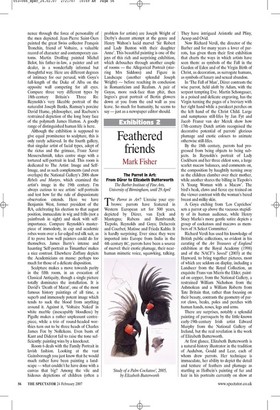Feathered friends
Mark Fisher The Parrot in Art: From Diirer to Elizabeth Butterworth The Barber Institute of Fine Arts, University of Birmingham, until 29 April The Parrot in Art? Unraise your eyebrows: parrots have featured in Western European art for 500 years, depicted by Darer, van Eyck and Mantegna; Rubens and Rembrandt; Tiepolo, Reynolds and Goya; Delacroix and Courbet; Matisse and Frieda Kahlo. It is hardly surprising. Ever since they were imported into Europe from India in the 4th century BC, parrots have been a source of marvel: their exotic plumage, their nearhuman mimetic voice, squawking, talking.
They have intrigued Aristotle and Pliny, Aesop and Ovid.
Now Richard Verdi, the director of the Barber and for many years a lover of parrots, has given them their first exhibition that charts the ways in which artists have seen them: as symbols of the Fall in the Garden of Eden and of the Virgin Birth of Christ, as decoration, as surrogate humans, as symbols of luxury and sexual abandon.
In 'The Fall of Man', Darer contrasts the wise parrot, held aloft by Adam, with the serpent tempting Eve. Martin Schongauer, in a poised and delicate engraving, has the Virgin turning the pages of a breviary with her right hand while a parakeet perches on the left hand of the Christ Child. Large and sumptuous still-lifes by Jan Fyt and Jacob Fransz van der Merck show how 17th-century Dutch artists recognised the decorative potential of parrots' glorious plumage and exotic colours to animate otherwise still-lifes.
By the 18th century, parrots had progressed from being objects to being subjects. In Reynolds's portrait of Lady Cockburn and her three eldest sons, a large scarlet macaw balances, and comments on, the composition by haughtily turning away as the children clamber over their mother, while another shares the billing in Tiepolo's 'A Young Woman with a Macaw'. The bird's beak, claws and fierce eye trained on the viewer contrast with the woman's bared breast and milky skin.
A Goya etching from 'Los Caprichos' sets a parrot up above the vacuous stupidity of its human audience, while Henry Stacy Marks's more gentle satire depicts a group of cockatoos and macaws as members of 'A Select Committee'.
Richard Verdi has used his knowledge of British public collections, so evident in his curating of the Art Treasures of England exhibition at the Royal Academy (1998) and of the NACF's Saved! (2003) at the Hayward, to bring together pictures, most of which are seldom on display, including a Landseer from the Royal Collection, an exquisite Frans van Miens the Elder, painted on copper, from the National Gallery, a restrained William Nicholson from the Ashmolean and a William Roberts from Tate Britain that, rather than focusing on their beauty, contrasts the geometry of parrot claws, beaks, poles and perches with human hands, noses, legs and arms.
There are surprises, notably a splendid painting of parroquets by the little-known early-19th-century Irish artist Edward Murphy from the National Gallery of Ireland, but the real revelation is the work of Elizabeth Butterworth.
At first glance, Elizabeth Butterworth is a natural-history illustrator in the tradition of Audubon, Gould and Lear, each of whom drew parrots. Her technique is immaculate, her ability to depict the detail and texture of feathers and plumage as startling as Holbein's painting of fur and hair in his portraits currently on show at Tate Britain. She is also a superb colourist, plumbing the shaded depths of indigos and blacks, of petrol blues and greens. In her gouache of a Roseate Cockatoo's wing and her watercolour of the wing of Banksian Cockatoo, she is poised between scientific recording and imaginative art. Go and look, and wonder.























































 Previous page
Previous page